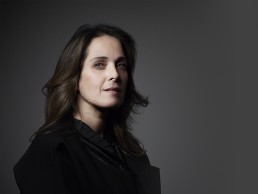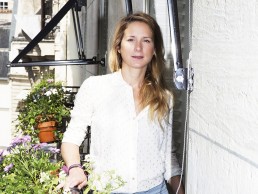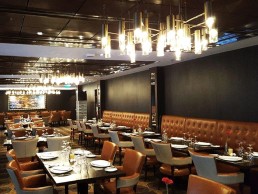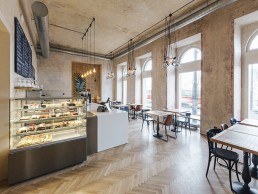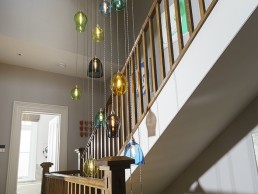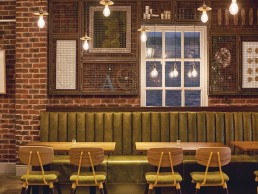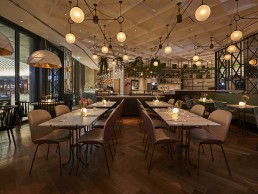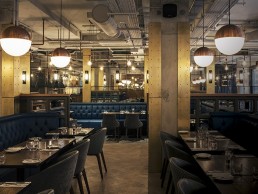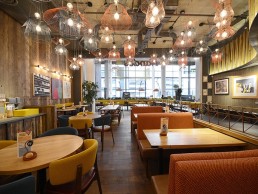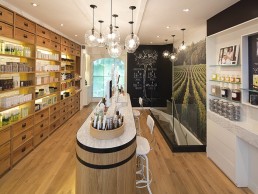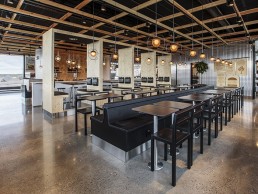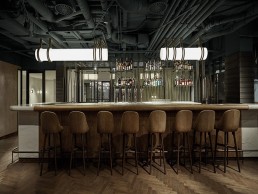Maha Kutay
Zaha Hadid Design creates a variety of pieces from architecturally inspired homeware to limited edition furniture and lighting, as well as innovative installations and interiors. darc spoke with Maha Kutay, Director of Zaha Hadid Design, to find out how the studio continues to push the boundaries of traditional design methodologies.
Zaha Hadid’s product design and architecture have always been connected - with some of the earliest projects, product designs and interiors part of the studio’s repertoire from the very beginning, and the strong connection between the two completes the experience architects try to realise for the user to some extent. Whether in large scale such as buildings, or small scale such as lighting, architects are designing for the end user. Many of the same ideas and principles used in the studio’s architecture can be applied to its product design.
Design Director Maha Kutay studied environmental design from Parsons School of Design, New York followed by a master’s degree in architecture from Columbia University, New York in 1994. Having joined Zaha Hadid Architects in 1995 Kutay has been involved in a number of major architectural projects. After a short time away from the studio, she returned to lead the team at Zaha Hadid Design.
Commenting on the studio’s ‘design style’, Kutay tells darc: “The work explores the potential for a new language of architecture and design that is driven by the many new possibilities created by significant technological advancements in 3D design software, as well as our inherent desire to test and engage with both traditional and innovative new manufacturing capabilities.
“The design language explored within each collection emphasises seamlessness and the smooth transition between elements. Each piece, while initially morphologically conceived is shaped further by typology, functional and ergonomic considerations.”
Zaha Hadid Design has collaborated with a number of lighting brands throughout the years, with some of its most notable pieces including: the Genesey lamp for Artemide; Vortexx chandelier for Zumtobel in association with Sawaysa & Moroni; Eva & Dune for Lasvit; Swarm chandelier for Established & Sons; Luma for Wonderglass; and Slamp’s Aria and Avia pendants.
“Collaborations provide us with an opportunity to express our ideas through different scales and different media,” says Kutay. “We see it as part of a continuous process of our on-going design investigation. It’s a two way process – we apply our architectural research and experimentation to these designs, but we also learn a great deal from the process of product design.
“One of the most satisfying things about the product design collections is that the techniques used for design and manufacture – and the production process between idea and result – is so much quicker than for architecture. This faster timeframe leads to greater opportunities for experimentation; particularly in the design of furniture and products for the home where we have the possibility to create real prototypes very quickly and we can immediately evaluate the design for performance and functionality.
“There’s a lot of fluidity now between architecture, design and fashion, there’s a lot more cross pollination in the disciplines. But this isn’t about competition it’s about collaboration and what these practices and processes can contribute to one another.”
For the studio, lighting is an important and very effective medium of architectural articulation and definition of space. It is also a major component with respect to creating a pleasant and effective environment for work and face-to-face communication.
“We consider each lamp or chandelier design a microcosm of the same ideas inherent within our architecture. Form does not follow only function but instead, is also derived from fabrication methods and the quality of light and space to define context and provide dramatic punctuation. Advanced 3D modelling software and rapid prototyping enables our teams to evaluate lighting equipment, detail with confidence, and experiment with various approaches.”
The design studio strongly believes in a collective, multidisciplinary approach to problem-solving, making use of robotics, 3D printing, artificial intelligence, augmented reality and big data, which are all impacting architecture and design and revolutionising both industries. “Evolving technologies are changing how we design and create new collections that convey the coherence of natural forms but are completely modern in expression.
“We regularly welcome new talent to the company as well,” continues Kutay. “They contribute to the discourse and bring their own specialist knowledge and expertise to each design. They are encouraged to be part of the progress we make each day.
“Every new design benefits from the inventiveness and abilities of others. Teamwork was very important to Zaha – she always believed in it – and Zaha Hadid Design continues to work with the same principles and methods.”
Zaha Hadid Architects / Zaha Hadid Design continue as one of the most innovative and successful design studios in the world. Its directors are among the most experienced architects in the industry, collaborating with Zaha herself for many decades, to deliver some of the world’s most renowned designs.
“Zaha will always be embedded within the DNA of Zaha Hadid Design,” says Kutay. “Her unwavering belief in the power of invention continues to drive and inspire us every day and we work on as she taught us – with curiosity, integrity, passion and determination.”
Dorothee Meilichzon
darc caught up with award-winning interior designer Dorothee Meilichzon to find out who and what inspires her and how lighting is integral to her designs.
DREAMS OF DESIGN
For as long as I can remember I wanted to be a designer. It was as soon as I discovered Raymond Loewys’ work. Also, Philippe Starck was big at the time and his approach was really new. I grew up in Paris surrounded by many entrepreneurs in my family, so it’s no wonder I decided to start my own business in 2009.
STUDYING
Industrial Design at Strate College is quite a different discipline to that of interior architecture and as I hadn’t ever worked for an interior architectural firm, I had to learn everything myself. I worked as a graphic designer, product designer and a bit of retail design for design agencies, for about five or six years before starting my own company.
INSPIRATION IN HISTORY
I had quite a classical education and as such am always very interested in classic architecture and ornamentations. The history of a building can be a big inspiration. My studio is multidisciplinary for sure; I love to learn so am always looking for new things to discover.
TIMELESS STYLE
This is how I would best describe my ‘signature style’, it’s a bit timeless and graphic, with a mix of different styles and time periods. My studio’s philosophy is to be guest / consumer orientated – we are working in places where we want people to feel good and get together. Nothing complicated, just good vibes and this is why our interiors need to fit with the building and its own story.
BEST OF THE BEST
I was really happy to have been chosen as Best Designer in 2015 at Maison et Objet and then included in the Wallpaper* 20 Best Interior Designers - it was a huge honour and completely unexpected! I hope, moving forward, I will continue to reinvent myself and my designs - getting better all the time!
LIGHTS & MIRRORS
These two things are very important to me as they create the atmosphere. I have to say, I am fighting a bit against LED lamps, as from the ones I’ve seen I don’t like the light scattering of them. Material wise, brass, aluminium, glass and china are things I like – materials that will embellish the light. We design our own lights most of the time now, but also work with small lighting companies that I love.
STAND OUT DESIGN
For me, this would be the Prescription Cocktail Club, where we had this cute wall light made of petals of porcelain – light played really well with those. Also, in NYC at the Experimental cocktail club we had some suspension lights from a Swedish designer that were a tribute to the Chinese heritage of the neighbourhood. I stained the silk used for the lights myself and it’s a nice memory to have. Each project we work on has its own unique lighting requirements.
BRASSED OFF
In the world of interior design, when it comes to trends, I hope to see a continued growth in the use of aluminium. I have had enough of brass lighting now - it is time for a change. In the early 2000’s everything in interior design revolved around chairs… now, lighting is the new chair!
Ovation of the Seas, Worldwide
The Ovation of the Seas is the second largest cruise ship in the world operating for Royal Caribbean International. Lighting consultants Project International specified the Illumis Lights Comfort Dim lamps throughout, offering a blend of characteristics rarely found in the fast developing LED lamp market.
Illumis Lights' Comfort Dim lamps offered the opportunity to combine a mix of two colour temperatures within one lamp to set a range of alternative ambient settings. The lamps were used throughout the hospitality sectors of the vessel to create the appropriate settings for every occasion with programming utilising Helvar dimmers. In one of the restaurants, 1,000 units were specified – reducing the overall temperature of the setting significantly.
Smetanaq House - Czech Republic
The Smetanaq house at 4 Smetanovo nábřeží is a place where people with a shared interest in art, culture and design come together. Its three floors are home to the Smetanaq Gallery as well as studios of young designers on the second floor called ‘Bottega’ after the Italian model. In addition there is the Deelive Design Store (which offers the work of some of the best Czech fashion and interior designers) and Smetanaq Cafe & Bistro on the first floor, serving quality coffee and appetizing desserts. It’s an excellent place for breakfast or to simply spend an afternoon enjoying one of the most beautiful views of the Vltava River, Prague Castle and Petřín Hill.
The minimalistic interior of Smetanaq house is highlighted by the crystal pendants from Bomma - a leading Czech design brands, with its beautiful contradiction of fragile mouth-blown crystal and rope, the Shibari pendants are the most significant eye-catchers of the Smetanaq Cafe & Bistro. On top of that, Bomma crystal pendants are also part of Bottega and Deelive Design Store, which testifies the Smetanaq main aim - to connect and promote the best of Czech design.
The classical-style townhouse was built between 1846 and 1847 and was originally conceived as an apartment house, though during the course of the 20th century, underwent reconstruction several times, became an office building, which was damaged by a huge explosion on Divadelní Street in 2013. The blast destroyed the load-bearing masonry and part of the ground floor ceiling of the Divadelní Street wing collapsed. The original owner made the house safe and secure through expensive repairs and then sold it. At present the part of the house on Smetanovo nábřeží has been completely reconstructed. During the reconstruction architects Jiří Řezák and David Wittásek from Qarta Studio dealt with the insensitive interventions of previous decades, removing all the plasterboard on the ceilings and walls to reveal the beautiful palatial features of the original Burgher house. During this process they uncovered remnants of the original paintwork, which they later incorporated into the overall interior design.
Residential Project, UK
Having already developed a single suspension bar to work over dining tables and kitchen islands in particular, it was a natural progression for Curiousa & Curiousa to play with a double bar option. The double bar suspension chandelier plate supported 20 pendants, each differing in height, form and colour to provide a stunning cascade.
“Working with the client, we selected colours that would complement her existing interior and artwork - especially the treasured portraits of her children hung on the stairway leading to their bedrooms,”said Director,Esther Patterson.
To complement the glass pendants Esther used LED lamps from Well-Lit which has developed a range of dimmable lamps thatnot only look stunning but are also ethically manufactured.
“Who we work with and how we work is incredibly important to us. We always want to use local, UK-based craftsmen and women wherever possible - but when it isn’t, such as in LED lamp manufacturer, it’s important to find a supplier that reflects our values. So we were delighted to meet Chris from Well-Lit who has won awards for his ethical approach to Chinese manufacture whilst also advancing the technical aspects of the lamps, developing unique, discreet and reliable drivers. For us it’s the perfect partnership. Every stairwell chandelier we design throws up its own problems - no two are the same. For the client's chandelier, in this project, not only was the space between the bannisters tight, the ceiling also sloped into an atrium. But solving problems is all part of the fun!” enthused Patterson.
Saint Paul's House Hotel, UK
The Saint Paul’s House Hotel is a boutique bar and restaurant in the heart of St Paul's square, Birmingham. A contemporary mix of modern design with a Shoreditch eclectic style interior. To complement this, lamps from Megaman’s Dim to Warm, VersoFIT downlighters and Gold Filament range were specified throughout the hotel.
Installed by 3ci Lighting, Megaman 10.5W Dim to Warm LED lamps were used in the hotel bedrooms to help create a relaxed and comfortable ambiance. Simulating the same warm light and dimming characteristics of incandescent and halogen lamps, the LEDs provide a colour temperature range of 2700K to 1800K, without the additional heat emissions traditional halogen lamps produce. Megaman 8W VersoFit fire-rated downlighters were installed within the bedroom en-suite areas. Available in three finishes, they offer an unobtrusive option. The integrated driver technology and serviceable LED module also ensures easy installation and maintenance; reducing servicing costs for the hotel. Furthermore, the downlighters are IP65 rated – a requirement for bathroom installations.
Three styles of Megaman Gold Filament lamps from its popular economy series were also installed in the hotel’s bar and restaurant area. By including 200 lamps of the Classic, Globe and ST58 lamp shapes, it helped the hotel to create a stunning visual effect and the luxurious warm glow required. Providing an excellent lumen output of 210 lumens1/W, the lamps emit a rich gold hue thanks to its 2200K colour temperature. Additionally, the lamps are extremely energy efficient with a service life of 15,000 hours.
Demoiselle by Galvin, UAE
Demoiselle by Galvin is the latest venture from Michelin-starred chef’s Chris and Jeff Galvin. The concept expands upon their flagship restaurant located within Harrods department store, London.
Located in Dubai, the concept behind the restaurant’s design was inspired by a charming chateau that Chris stumbled upon on a trip to Champagne, France. Inside the Art Deco building he discovered an ornate collection of paintings illustrating beautiful birds of paradise and decadent Parisian women adorned in a feminine pastel-hued palate. DesignLSM was tasked with making this vision a reality.
Downstairs the café provides a sophisticated and relaxed environment with a unique blend of casual seating including luxurious leather banquettes, upholstered dining chairs and intimate bar stools which set against an impressive open kitchen counter offering guests the chance to experience an avid sense of culinary theatre. A fresh palette of dusty pinks and hues of mint green conjure an air of understated elegance with aged mirror screens and herringbone oak flooring bringing a more traditional feel. Scattered across the ceiling is a stunning array of bespoke geometric pendant lights designed and manufactured by Into Lighting. Frosted antique glass globes highlighting the beautiful bespoke finishes such as the brass trimmed marble topped tables. The grand staircase leading diners upstairs is enriched by an arresting double height panel mirror and glass display cabinet showcasing a beautiful vintage collection of tea and coffee pots while the top of the stairs is dressed with an exquisite hanging garden wall lit by low-hanging lights.
Industrial Flow
(UK) - Inspired by Kingston’s rich aviation heritage, the Double Tree Hilton is located a stone’s throw away from the River Thames in an airy, corner building bathed in natural light. The overall design scheme of the hotel’s interior holds a warm and contemporary aesthetic with subtle touches of aircraft paraphernalia in honour of Australian aviation pioneer Harry Hawker.
Interior designers Design LSM worked closely with lighting designers Light Corp '93 (formally The Light Corporation) to devise a design that aided the flow of the space while also clearly defining separate areas by using prominent statement pieces to separate the open space of the ground floor décor and seamlessly blend each area together.
Guests entering the lobby are greeted by a welcoming, social space, with a blend of relaxed seating and tables. A grand ten-metre bar features architectural lighting, which illuminates the area and its rich copper façade carefully merges the lounge into Hawkers Bar & Brasserie. Custom brass feature pendants cover the lounge and bar area providing soft ambient lighting through bare globe filament lamps. All of the pendants and spotlights in the restaurant are finished in copper to match the scheme’s design, whilst the bar and decorative features throughout the lobby are finished in matching brushed brass. These small coordinated details assist the cohesion of the lighting with the other furniture, fixtures and equipment in the space. A warm palette of copper, teal and soft greys bring the interior of the bar and restaurant to life, with its rich leather seating, bespoke opal globe pendants and ornate floor tiles conjuring up an air of elegant opulence, while the low-level mirror screens and an exposed statement ceiling offer a modern industrial feel.
Bright Good’s sepia tinted maxi globe lamps are hung bare and installed in clusters amongst copper pipework that runs around the perimeter of the restaurant, while the task lighting in the dining space is provided by copper surrounded spotlights fixed to the same feature. Display lighting for the wall mounted shelving is provided by in-joinery LED strips and downlights.
In order to give the brassiere an independent feel to the rest of the space the designers created an enticing exterior entrance complete with bespoke glass doors and an enclosed terrace allowing for al fresco dining all year round. Bespoke glass pendants were designed and mounted to a custom canopy with matching Original BTC Davey Box wall lights and warm filament lamps used to illuminate the outdoor area.
Design LSM Project Director Andy Harwood worked on the renovated space for ten months to bring several elements together in a cohesive, multi-functional environment.“There was a lot of functionality needed in a space that wasn't necessarily deigned for that purpose,” Harwood explains. “There are different stakeholders with different criteria, in one space you have someone who wants to operate a restaurant and there’s a hotel that needs to function as a hotel as well as a Hilton franchise. We had to come up with different techniques to divide the space into separate areas. A lot of the service routes had to be changed and redirected across spaces you wouldn't usually have in a building specifically designed to be a hotel.”
For both the interior designers and lighting designers the project’s main challenge was working with a complicated and difficult concrete building. Matt Parker of Light Corp '93 explains: “The building had exposed services, columns, ledges and bulkheads, all obstacles for cable tray positions, large light features and the continuous copper pipe light system that runs throughout the restaurant. Multiple coordination drawings and site meetings were the only way a workable solution could be found and even then the challenge was tough.
“As tough a challenge as the initial layout was, the seamless flow of the space and definition of individual areas stand out thanks to the carefully considered lighting design, Parker continues. “All of the light fittings were specially designed for the project using our in-house designers and manufacturing facility. This enabled us to match copper and brass finishes to maintain a consistent look and feel to the decorative products. The design worked well and formed a comfortable, warm atmosphere – dynamic enough to provide both a light and airy breakfast environment and then a moody, romantic evening atmosphere.”
Using a mixture of soft ambient lighting from pendants to direct artwork lighting and accent lighting for columns, displays and wall finishes – Design LSM and Light Corp '93 developed an interesting, layered lighting scheme to sit within the general interior, bringing warmth to an otherwise harsh industrial space and enhancing the Art Deco style of the interior. The carefully considered lighting scheme aids the flow between the restaurant/ bar and the hotel’s functional areas seamlessly.
Nando's, UK
Enigma Lighting working together with B3 Designers, was tasked by Nando's to create a unique and exciting restaurant lighting design within the new Southampton West Quay extension, communicating the brand of Nando’s whilst acknowledging the location and context of the restaurant.
The biggest challenge for the design team was to create a number of bespoke, multi coloured wire framed pendants, mimicking lobster pots in appearance (a nod to the city’s link to the sea), with various diameter, height and finish combinations to provide a stunning lit appearance and create a wow effect within the space for both the day and evening scene sets. Each of the feature pendant's design was based around a minimal lamp holder within independent control of the top and bottom lamps for maximum adaptability. The lamp chosen was the Enigma 125mm LED filament lamp which had the scale, output and colour temperature warmth that the design required.
Utilising their product design capabilities, Enigma Lighting designed and supplied further bespoke items such as a mesh style linear wall light, also utilising the Enigma tube linear filament lamp and a special adaptation of the Enigma Tubular luminaire, powder coated with the exact RAL of the ceiling to seamlessly blend these discrete spotlights into the ceiling and not detract from the main event of the feature wire pendants.
The restaurant is lit through a layers of light approach, putting lighting where it is required, balancing light levels and contrast to dress the space and not over dominate the various interior features within the space. Hidden lighting details are key to creating this balanced approach and the Enigma Lighting team worked closely with B3 to design the details needed to illuminate the feature relief woodwork used throughout the space in various joinery pieces, such as the feature bar and kitchen bulkhead and the external bench seating within the main promenade to the shopping mall. The result is a fully dimmable, all LED scheme that is both warm, inviting, enjoyable and relaxing to be in. The restaurant really holds its own within the West Quay mall’s promenade.
Caudiale, US
Founded in 1995, the global skin care brand Caudalie has grown extensively since its beginnings in France. Throughout the years it has expanded its roots far beyond its place of origin and now has locations in New York, Los Angeles and London.
The worldwide boutiques feature clusters of Niche Modern's Binary pendants in crystal glass and hang from varying drop lengths to form a stunning centrepiece, creating an inviting space where customers can sample products and speak to a beauty consultant. Pendant lighting installations often hang above a tester bar, housed in the centre of the store, as pictured above.
Each silhouette begins with a sketch from Niche Modern's Creative Director Jeremy Pyles, with every detail carefully thought out between a team of designers, glass artists, and technicians in itsBeacon, New York studio. After the Binary pendant is handblown in Niche's Hot Shop, it is inspected, cut, drilled, ground and polished by hand in the Cold Shop to ensure the highest standard of excellence.
“We try to do things that are not overly flourished, where the economy and line and shape is very simple," Pyles says about his lighting designs. “There's not so much elaboration and not a lot of fussiness.”
Based on the orb glass shape, the Binary modern pendant light is a multi-lamp fixture, giving it a contemporary twist to Niche's more classic Solitaire pendant light. These handblown glass pendants incorporate two A15 incandescent filament or A15 LED appliance lamps depending on a client's preference. Available in an array of luxurious glass colours ranging from crystal to crimson, the Binary pendant adds a timeless and elegant touch in any environment.
MAX Hamburgerrestaurant, Sweden
MAX Hamburgerrestaurant is Sweden’s oldest and fastest growing hamburger restaurant, established in 1968. By using honest materials such as wood, metal, stone and leather Wingårdh Arkitektkontor has translated the architectural space to better reflect the high quality food served at MAX every day.
The architects decided to play with volumes, creating rooms within rooms, both exterior and interior. Being a family business, MAX wants to be a sustainable company in a sustainable society, leading and creating an example in the industry. As a part of the environmental aspect, lighting brand BLOND was tasked with creating custom luminaires for the new concept. Being a family owned company too, with their production facilities in Sweden, sustainability has always been part of the very core of BLOND. By keeping the manufacturing process within its own walls, and utilising a high-effective LED lightsource, BLOND has been able to create luminaires for this project that reflect the environmental and social responsibility that is part of the MAX legacy.
Wyers Bar & Restaurant, The Netherlands
Wyers Bar and Restaurant is an art and ambience filled hotel close to Amsterdam's Central Station. After studying the historical context of the restaurant's location, Studio Modijefsky created an identity and interior for the new contemporary restaurant and coffee corner, that takes inspiration from the building's former use as a Dutch fabric store called Firma Wyers, with the fabric industry a strong starting point for the concept of the new restaurant.
Analysing the space and its location, a new layout was developed for the restaurant where the orientation of the building and outside traffic played an important role in the design. Located on the busy intersection of a pedestrian street and the main road leading tourists from Central Station into the city, the design was created to filter the surroundings and establish a softer environment away from the hustle and bustle. A subtle transition in materials, from hard to soft creates a relaxing atmosphere in the interior of the restaurant.
Bright ochre colours stand out against the greys and greens while creating an accent in the entrance, which is clearly visible from the street, showcasing the restaurant logo and a mysterious portrait of a young girl shot by local Dutch photographer Maarten Schroder. A weathered wall in clay coloured brown welcomes guests into a warm and cosy dining area while olive green walls and banquettes give a nod to the site’s former history with the backs and seats resembling fabric rolls stacked in a store.
The building's history works to further inspire and play a role in the design of the restaurant, as the design team uncovered a graveyard of tubing and insulation in the ceiling. Esther Stam of Studio Modijefsky explained: "The ceiling height was proving an issue for us and we wanted to open it up. This actually ended up working in our favour, we had no idea what had been hidden away until then and by this point we were already quite far into our drawings.
This discovery inspired the industrial design of the restaurant's open ceiling and pipework, where custom made lighting was built into a tube that hang from inside it in an impressive and surprisingly cohesive feature. The lighting tube runs throughout the space reminiscent of a thread weaving through a piece of fabric; growing from the sculptural wooden banquettes, these spatial lines make playful curves transforming into a light tube before disappearing again into one of the walls between the windows.
“Every banquette has its own light thread that appears and disappears, highlighting the seating area,” says Stam. The lights are made from steel and lightly powder coated so that the texture still shows through, while the tubing and the globes are made from Perspex. "The bar is an abstract version of a weaving machine and we felt the lights should also feel like a thread winding through the interior.”
Decorative tubes hanging from the ceiling, lit by spotlights, shine onto the show kitchen front, illuminating the food being served. The lamps are curved in the lower part as half circles to form a roll that wraps around the show kitchen. Metal tubing also decorates the bar's back wall forming the construction of the glass shelves holding the bottles displayed. The bar itself is a solid volume covered in end grain wood and off-white honed marble. The restaurant is finished with a dark wooden floor laid in a weaving pattern, which continues down to a lower level where the bathrooms are situated. Here, dark blue tiles complement green walls and custom made light boxes hanging from the ceiling shine onto green marble sinks. Special details give this space its own identity, such as the toilet rolls placed in the back wall, hanging like rolls of fabric.
“We wanted the space to be comfortable and accessible,” says Stam. “The brief was to create a space with a high level of service for a mixed crowd; the restaurant had to have a local feel in an area that is actually more occupied by tourists. There is a lot of foot traffic on the street but we had to think about making the restaurant stand out. The building itself doesn't have the same charm as a lot of older buildings in Amsterdam, so we didn't have that working for us, the historical architecture just wasn't there unfortunately.”
Outside, to draw attention to the façade, Studio Modijefsky designed several lamps that highlight the entrance of the restaurant, a light box with a life size pin, an icon that marks the logo of the restaurant pinpoints the entrance to the restaurant from the hotel, then there’s Miss Louisa the little coffee shop on the corner, named after the founder of the fabric store J.P Wyer's youngest daughter. Miss Louisa is a fun addition to the more serious restaurant space. A strong graphic appearance and a variation of black and white tiles combined with a custom steel light box on the brick façade attracts the crowds passing by.
Both designs are a welcome addition to the Kimpton De Witt, a chic and stylish hotel where the city’s history lives on and its pulsing energy thrives.
“All of the challenges the project threw at us worked in our favour, in a way,” Stem says. “The restaurant has a local flavour in a part of the city that doesn't feel very local, but that’s what makes it different, the coffee shop’s small space makes it standout, they’re hidden gems and those things that you have to discover usually give you the most pleasure.”

